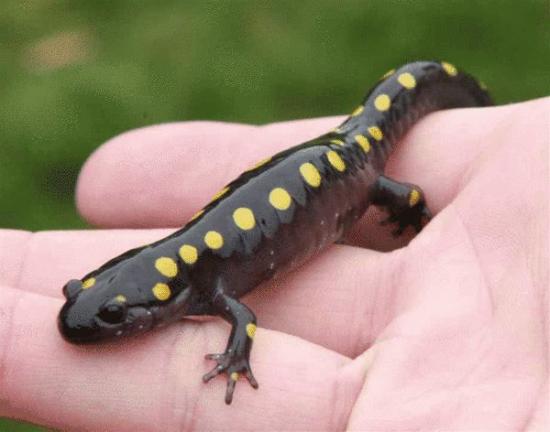导读:光合作用长久以来被认为植物、藻类、一些细菌以及少数无脊椎动物的绝技。这一观念现在要被打破了:科学家在脊椎动物中也发现了光合作用现象,它就是斑点钝口螈。

斑点钝口螈(spotted salamander )
长久以来,科学家们一直认为只有植物、藻类、一些细菌以及很少的无脊椎动物能通过光合作用直接从阳光中获取能量。现在,据著名的《自然》杂志报道,科学家首次发现了一种能进行光合作用的脊柱动物。
这种不可思议的动物实际上是一种非常常见的斑点钝口螈(spotted salamander)。具有讽刺意味的是,其实科研工作者对斑点钝口螈一点都不陌生,而且还知道该动物的胚胎和能进行光合作用的藻类有共生关系。然而,这种共生关系一直被认为是外在的,也就是说藻类和斑点钝口螈分别独立工作,然后平等的相互交换产物。
事实证明,科研工作者先前并没有进行足够细致的观察。来自达尔豪斯大学的科学家赖安•科内尔(Ryan Kerney)在研究一批斑点钝口螈的胚胎时发现了与传统的认知不一样的东西——从斑点钝口螈细胞内部发出了明亮的绿色光芒。绿色通常表明叶绿素的存在,它是一种吸收光的能进行光合作用的绿色色素。科内尔还获得了孵化前的斑点钝口螈胚胎的长时间曝光的荧光影像。在经过使用透射电子显微镜(TEM)观察之后,他确认了自己的猜想——那是生长在斑点钝口螈细胞之内的藻类共生体。

绿色藻类覆盖并进入到钝口螈胚胎细胞中(图:Photo courtesy of Roger Hangarter)
实际上,这种藻类共生体经常在线粒体(mitochondria)周边被发现,线粒体是负责为细胞产生能量的一种细胞器。因此,看起来线粒体能够直接从藻类获得氧气和碳水化合物,这正是藻类进行光合作用的产物。
这个科学发现令人惊奇的原因是,所有已知的脊椎动物都有着完善的免疫系统,它能够摧毁进入细胞内的外来非己生物物质。关于斑点钝口螈细胞内的藻类是如何绕开这种内在的生物防御机制的仍然是个谜团。
更有趣的是,科内尔还发现藻类存在于成年雌性斑点钝口螈的输卵管内,输卵管是胚囊形成的地方。这意味着,很可能共生的藻类是通过生殖过程从母亲传给后代的。
来自加州大学伯克利分校的大卫•威克(David Wake)在听取了科内尔的演讲报告之后说:“我怀疑藻类是否能够进入斑点钝口螈的生殖细胞,这将真正挑战传统的知识体系。”
虽然这是第一次在脊椎动物细胞内发现能进行光合作用的微生物,但是这向我们提出了一个开放性的问题——是否其它的动物也拥有着类似的性状?
发育生物学家丹尼尔•巴克霍尔兹(Daniel Buchholz)说:“我认为只要人们开始认真寻找,我们或许将会发现更多的这种事例。”

 Intracellular invasion of green algae in a salamander host
Intracellular invasion of green algae in a salamander host
Ryan Kerney, Eunsoo Kim, Roger P. Hangarter, Aaron A. Heiss, Cory D. Bishop, and Brian K. Hall
The association between embryos of the spotted salamander (Ambystoma maculatum) and green algae (“Oophila amblystomatis” Lamber ex Printz) has been considered an ectosymbiotic mutualism. We show here, however, that this symbiosis is more intimate than previously reported. A combination of imaging and algal 18S rDNA amplification reveals algal invasion of embryonic salamander tissues and cells during development. Algal cells are detectable from embryonic and larval Stages 26–44 through chlorophyll autofluorescence and algal 18S rDNA amplification. Algal cell ultrastructure indicates both degradation and putative encystment during the process of tissue and cellular invasion. Fewer algal cells were detected in later-stage larvae through FISH, suggesting that the decline in autofluorescent cells is primarily due to algal cell death within the host. However, early embryonic egg capsules also contained encysted algal cells on the inner capsule wall, and algal 18S rDNA was amplified from adult reproductive tracts, consistent with oviductal transmission of algae from one salamander generation to the next. The invasion of algae into salamander host tissues and cells represents a unique association between a vertebrate and a eukaryotic alga, with implications for research into cell–cell recognition, possible exchange of metabolites or DNA, and potential congruence between host and symbiont population structures.
文献链接:https://www.pnas.org/content/early/2011/03/29/1018259108







